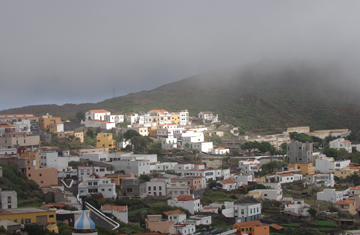
A general view of the Valverde town on El Hierro Island, January 13, 2010 in El Hierro Island, Spain.
At the moment, the project that will transform the future of El Hierro doesn't look like much more than a hole in the ground. Or two, to be exact: one on top of a mountain, another smaller one down below, and in between, a long stretch of pipeline tinted the same color as the scrub that grows so abundantly on this volcanic island. But when this innovative wind-power system goes online at the end of 2011, it will turn El Hierro, the easternmost of Spain's Canary Islands, into the first inhabited landmass in the world to become completely energy self-sufficient. And that's just the first step in a plan that may make the island the most sustainable place on Earth.
Sound ambitious? Consider the source. El Hierro is located over 750 miles (1,200 km) from the Spanish mainland, and its stark, volcanic landscape harbors no coal or fossil fuels. Fresh water is scarce, and for electricity, its population of 10,000 has long depended on the diesel brought in weekly by tanker. Which is why, some 25 years ago, the islanders began thinking about ways to convert to renewable energy, using the two resources that they actually have a lot of: wind and water. Now, with oil supplies dwindling worldwide and the Fukushima disaster offering an all-too-present reminder of the perils of nuclear energy, El Hierro's hydro-eolic plant looks positively prescient.
"At first, it was simply an issue of becoming more self-sufficient," says Tomas Padrón, president of the Island Council, whose role is similar to that of a mayor's. "We were completely dependent on outside deliveries and could be cut off at a moment's notice. But then with the global-energy crisis, and climate change, and everything else that's happened, we've realized it has a lot more value."
The future power station is at once a marvel of engineering and remarkably simple in its design. Five windmills on the northeastern end of the island will power a pumping station that, when the wind is blowing, will drive water 2,300 feet uphill, from a small, 5 million-cubic-foot (150,000-cu-m) reservoir down by the shore to a larger, 19 million-cubic-foot (550,000-cu-m) reservoir snuggled into one of the island's volcanic craters. When the wind abates, water from the top depository will be released, along 1.8 miles (3 km) of mostly camouflaged pipes, into the bottom one, and the pressure of that falling water will drive six hydraulic turbines. In other words, El Hierro will combine the two resources in which it abounds to deliver a continuous supply of electricity, no matter the weather. "If we don't want to depend on fossil fuel, we have to have steady input and output," says Gonzalo Piernavieja, director of research and development for the Technological Institute of the Canaries, which designed the plant. "And the only way to do that is through massive storage. In this case, we're using nature's gifts, wind and sea water, for storage."
The plant is expected to produce 48 GW/h (gigawatt hours), enabling El Hierro to conserve some 6,000 tons of diesel per year, and to meet 100% of its energy needs by 2015. And by that time, the island will be well into its next sustainability projects. One of them, already underway, is a plan convert all 4,500 of El Hierro's cars to electric; the same municipal company, Gorona del Viento, that is building the new hydroeolic station will supply car batteries powered by excess energy from the plant. "The whole system will be integrated," says Javier Morales, El Hierro's councilman for sustainability. "It's beyond green. When the power plant and the car system interact, it will be like galaxies colliding."
And that's not all that will be integrated. Unlike most of the other islands in the Canaries archipelago, which have staked their economies on mass tourism, El Hierro remains largely agricultural (pineapples and mangos are its primary exports). Its farmers too are looking ahead: all of the island's agricultural cooperatives have signed on to a plan that will convert their fields to organic production in the next eight years. And those farms, in turn, will be connected to a "biodigester" that converts sewage into both methane (which can then be used as fuel) and fertilizer.
How did a place so small that it lacks a movie theater and so culturally conservative that it still frowns upon unaccompanied women in bars come up with such a revolutionary plan for the future? Thank geography, says Island Council president Padrón. "We've always been doubly isolated, first from mainland Spain, and then from the rest of the Canaries," he says. "And we've always had problems with drought and with supplying ourselves. It makes us look harder for solutions."
But if El Hierro's problems are particular, its solutions don't have to be, say officials. "Absolutely this technology can be applied elsewhere," says Morales about the power station, whose upper reservoir is currently being lined with massive sheets of PVC in preparation for the first water pumping. "Hawaii, for example. We're already advising them." That's something that another volcanic archipelago, notably larger but perhaps newly aware of the limits of conventional energy, might want to look into.
